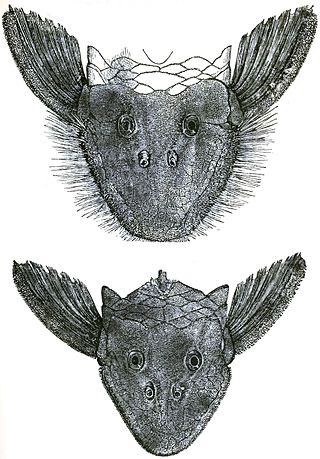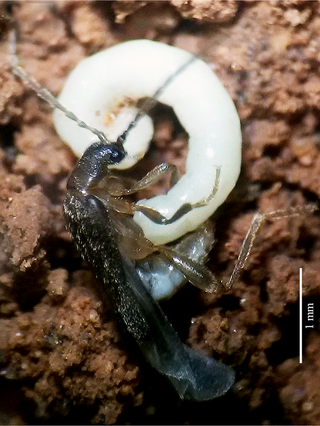
Club de Regatas Vasco da Gama, commonly referred to as Vasco da Gama or simply Vasco, is a sports club based in Rio de Janeiro, Brazil. Although originally a rowing club and then a multi-sport club, Vasco is mostly known for its men's football team, which currently competes in the Campeonato Brasileiro Série A, the top tier of the Brazilian football league system, and in the Campeonato Carioca, the top tier of the of Rio de Janeiro state football league system.

Hypostomus is a genus of catfish in the family Loricariidae. They are native to tropical and subtropical South America. H. plecostomus is the popular freshwater aquarium fish formerly known as Plecostomus plecostomus. The taxonomic structure of the Loricariidae is still being expanded by scientists. Hypostomus is a highly species-rich and widely distributed catfish genus.

Unaysaurus is a genus of unaysaurid sauropodomorph herbivore dinosaur. Discovered in southern Brazil, in the geopark of Paleorrota, in 1998, and announced in a press conference on Thursday, December 3, 2004, it is one of the oldest dinosaurs known. It is closely related to plateosaurid dinosaurs found in Germany, which indicates that it was relatively easy for species to spread across the giant landmass of the time, the supercontinent of Pangaea.

Stegomastodon is an extinct genus of gomphotheres, a family of proboscideans. It ranged throughout North America from the early Blancan ~4 Ma, to the early Irvingtonian. The South American species have been synonymized with Notiomastodon platensis.

Itabira is a Brazilian municipality and a major city in the state of Minas Gerais. The city belongs to the Belo Horizonte metropolitan area mesoregion and to the Itabira microregion.

Queimados is a municipality located in the Brazilian state of Rio de Janeiro. Its population was 151,335 (2020) and its area is 75 km². The city is divided into 37 districts.

Pseudancistrus is a genus of suckermouth armored catfishes native to South America.

The Hypoptopomatinae are a subfamily of catfishes of the family Loricariidae, composed of 17 genera and approximately 80 species. This subfamily represents about one-tenth of all loricariid species.
Neoplecostomus is a genus of fish in the family Loricariidae native to South America. Neoplecostomus can be distinguished from all other loricariids by a modified shield of small plates on the abdomen with posteriorly directed odontodes; the shield appears to act as a holdfast. The color pattern is generally mottled brown with the abdomen white. The head is long, rounded, and shovel-shaped. The fin spines are weak. They range from about 8 to 11 cm (3.1–4.3 in) SL. The species of Neoplecostomus live in fast-flowing water.

The minute tree-fungus beetles, family Ciidae, are a sizeable group of beetles which inhabit Polyporales bracket fungi or coarse woody debris. Most numerous in warmer regions, they are nonetheless widespread and a considerable number of species occur as far polewards as Scandinavia for example.
Cheiromyia is a genus of flies in the family Dolichopodidae. It is found in the Neotropical realm. It was originally named Cheirocerus by Octave Parent in 1930, but was renamed to Cheiromyia by C. E. Dyte in 1980 after it was found to be preoccupied by the catfish genus Cheirocerus. The antennae of the males bear one or more elongate projections on an enlarged postpedicel, resembling antlers. Cheiromyia is closely related to some species of Paraclius.

Flávia Lopes Saraiva is a Brazilian artistic gymnast. She represented Brazil at the 2014 Summer Youth Olympics in Nanjing, the 2016 Summer Olympics in Rio, and the 2020 Summer Olympics in Tokyo. She was part of the teams that won silver at the 2023 World Championships, gold at the 2018 South American Games and bronze at the 2015 and 2019 Pan American Games. Individually she is the 2014 Summer Youth Olympic floor exercise champion, the 2023 World Championships floor exercise bronze medalist and is a multi-medalist at the Pan American Games, South American Games, and Pan American Championships.
Aliocis is a genus of tree-fungus beetle in the family Ciidae. It was described by Sandoval-Gómez and Lopes-Andrade in 2015, as a replacement name for the genus Anoplocis, preoccupied by a genus of true weevils.

The 2016 Primeira Liga is the first edition of a football competition held in Brazil. Featuring 12 clubs, the Minas Gerais and Santa Catarina leagues provide three entrants, while Rio de Janeiro, Rio Grande do Sul and Paraná provide two each.
Ciini is a tribe of minute tree-fungus beetles in the family Ciidae. There are at least 30 genera in Ciini.
Neopleurotomoides aembe is a species of sea snail, a marine gastropod mollusk in the family Raphitomidae.

Jurasaidae is a family of elateroid beetles known from around a half-dozen species in two genera found the Brazilian Atlantic rainforest including drier transitional areas bordering the Caatinga. All known species have neotenic larva-like females and normal males, similar to some other elateroids. They occur in the soil horizon immediately under leaf litter, with the larvae likely being fungivorous, consuming the fluids of fungal hyphae.

Astyanax argyrimarginatus is a small species of freshwater fish native to various river basins in Brazil. Originally thought to be restricted to the Tocantins-Araguaia river system, a study in 2012 expanded its range to include the Rio Xingu, as well. Specific biotope preferences are unknown, but it is mostly collected from clearwater streams in fairly good health. Its relative abundance and presence in some protected locales means that it is not endangered.












